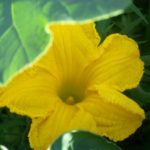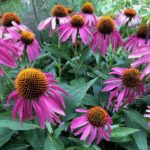
Basic Permaculture Concepts and Definitions
The concept of permaculture was first articulated by Bill Mollison and David Holmgrem in Australia during the 1970s. They published a book on their ideas and practices in 1978, Permaculture One. At that time the working definition of permaculture was: an integrated evolving system of perennial or self perpetuating plant and animal species useful to humans.
Permaculture ideas have continued to evolve and there are now many definitions. But they all encompass the idea of ecological design and the understanding that humans are a part of the system, not separate from it.
Here are a few others: Permaculture is a philosophy of working with, rather than against nature; of protracted & thoughtful observation rather than protracted & thoughtless labor; of looking at plants & animals in all their functions, rather than treating any area as a single-product system. — Bill Mollision
Permaculture is – Consciously designed landscapes which mimic the patterns and relationships found in nature, while yielding an abundance of food, fiber and energy for provision of local needs. People, their buildings and the ways in which they organize themselves are central to permaculture. Thus the permaculture vision of permanent or sustainable agriculture has evolved to one of permanent or sustainable culture. — David Holmgrem
Permaculture is an ethical design tool, creating sustainability through the integration of diversity, stability, & resilience in ecologically-sound, economically-viable human environments respecting the whole of creation. — Dawn Shiner
If we think of practices like organic gardening, recycling, natural building, renewable energy and even consensus decision making and social justice effort as tools for sustainability, then permaculture is the toolbox that helps us organize and decide when and how to use those tools. Permaculture is not a discipline in itself but rather a design approach based on connecting different disciplines, strategies and techniques. — Toby Hemenway, from his book Gaia’s Garden
Permaculture brings together traditional indigenous land management practices, ecological design and sustainable practices to create landscapes that are more than the sum of their parts — Eric Toensmeier from his book Paradise Lot
Key Permaculture Concepts
Connectedness – everything on the planet is part of one system. What we do impacts other parts of the system. Living and designing systems with this perspective helps us make healthy and ethical choices.
Zones – an area of activity defined by its relation to the most active part of the system which is zone 1 (usually home, school, etc), and ending with the areas needing the least activity or care.
Edge – the place where different environments or systems meet (field and forest, ocean and shore, city and country) which can be a place of more diversity, interest, and high adaptability
Stacking – growing multiple plants in one space by using stories. The concept of forest gardens is an example of stacking in which a forest might have trees that provide nuts, an understory of brambles which provide fruit, and a ground story that provides mushrooms.
Multi-function – when possible choose plants and other design elements that have multiple functions. For example, fava beans provide a source of high protein food and also nitrogen for the soil.
Guilds – communities of organisms that support each other in various ways and make the family of organisms more resilient than if they were existing alone.
The Ethics of Permaculture
- Care of the earth
- Care for people
- Sharing the Surplus
Design Principles of Permaculture as identified by David Holmgren in Permaculture Principles and Pathways Beyond Sustainability:
- Observe and Interact
- Catch and Store Energy
- Obtain a yield
- Apply Self Regulation and Accept Feedback
- Use and Value Renewable Resources and Services
- Produce No Waste
- Design From Patterns to Details
- Integrate Rather Than Segregate
- Use Small and Slow Solutions
- Use and Value Diversity
- Employ Edges and Value the Marginal
- Creatively Use and Respond to Change
Books
- Permaculture, A Designer’s Manual, Bill Mollison. This is the book that first laid out the concept of permaculture in 1988. Mollison together with David Holmgrem developed practices and a philosophy about creating sustainable food production systems and communities. This book is something of a tome and might not be the best book to start with, however it IS the original thinking on the subject.
- Introduction to Permaculture, Bill Mollison. A shorter version of the Designer’s Manual.
- Permaculture Principles and Pathways Beyond Sustainability, David Holmgrem. Published in 2002, expands on the practice of permaculture and establishes twelve philosophical principles applicable to much more than food production. This would be a great book to explore with older students, discussing each of the principles and how they could be practiced.
- Gaia’s Garden, a Guide to Home Scale Permaculture, Toby Hemenway. This book is a practical manual with lots of information on specific plants and techniques that can easily be implemented.
- Paradise Lot: Two Plant Geeks, One-Tenth of an Acre and the Making of an edible Garden Oasis in the City, Eric Toensmeier and Jonathan Bates. Published in 2013, a great read that is one part excellent resource about specific plants and techniques and one part personal journal and journey about implementing permaculture in a city lot on a low budget.
- Uncommon Fruits for Every Garden, Lee Reich. Native and wild fruits are often hardier and more disease resistant than their cultivated relatives. (They may also be smaller and not as sweet.) This book provides information on many unusual fruits that can be easily grown and provide interest in the garden.
- Edible Landscaping, Rosalind Creasy. This is not a book specifically about permaculture, but is a great resource for both usual and unusual perennials, and how to grow them, with specific variety recommendations.
Websites
- Permaculture Institute. Lots of articles and resources.
- Permaculture Activist. Lots of articles and resources.
- Plants for a Future. A searchable database of over 7,000 plants, an excellent resource and free.

